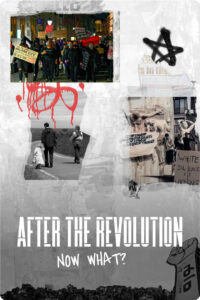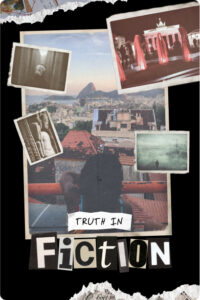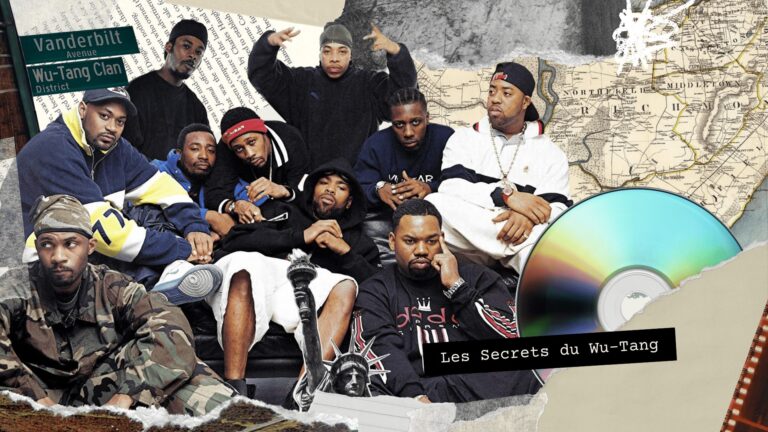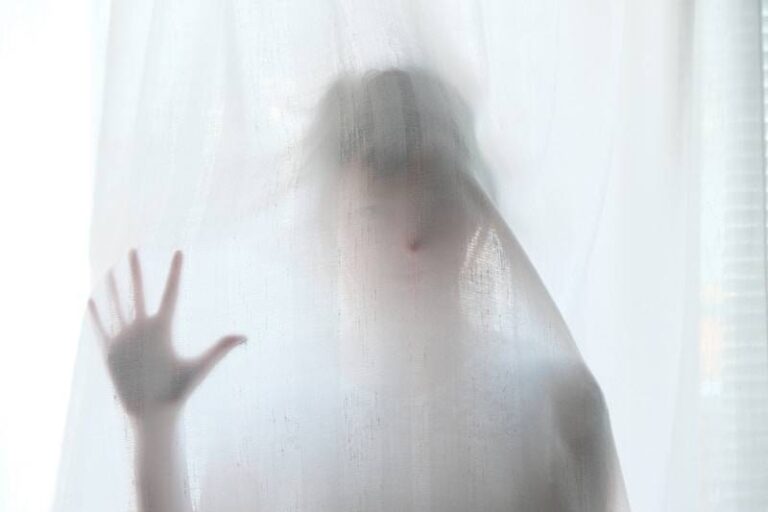Chapter 1 – The metaphysics of Popa Wu
As any other die-hard fan would, Lil’Louis followed them around everywhere. He always schlepped with him a massive photo album of the internationally famous group named Wu-Tang Clan. Allow me to briefly light your little lanterns and guide the way in what can be considered the pitch dark, a long and deep hallway that characterizes the genesis of this miraculous group.
In 2015, when Lil’Louis was seventeen, the end of a concert was the moment his biggest dream had come true: He managed to approach RZA, the de facto leader of the group, and had him sign the vinyl he’d bought off Ebay especially for the occasion: The original edition of the album 36 Chambers that had cost him a goddamn arm and a leg! Now that record is carefully stowed in a drawer in his room like a relic, with the same care that pictures of Jesus’s resurrection get in the middle of Queensbridge Houses. The Wu-Tang are arguably the Rolling Stones of rap. If your old man has ever danced to a riff from the delta (we’re talking about Mississippi of course), the mere mention of the name Rolling Stones would be enough to send him into a trance or to even make him levitate, if he’s a yogi. Simply put, RZA is Mick Jagger. Be sure to get that through your head before reading this story. They’re the greatest rap group on the planet. And to think that all of this began in a New York borough that tourists have always turned up their noses at: Staten Island.
Lil’Louis spared no effort, actually, and took many a return trip on the Manhattan-Staten Island Ferry. He isn’t exactly a Staten Island native because he grew up around New Lots in Brooklyn. But now that he’s familiar with the locals, all of Shaolin (Staten Island’s nickname) reveals itself to him. It took him a while to his introduction to this man that could only be seen as the true leader of that cryptic maze that is the Wu-Tang. Take Ol’Dirty Bastard (a member of the clan who died from an OD the 13th of November 2004, considered the joker of the group) and the interplanetary riot raging on in his burning dome (head), for instance. Who else but Popa Wu could have harnessed such an unhinged tornado? He’s the same guy who recently confronted cook/rapper Action Bronson at Sean Price’s wake. Popa Wu is like Andrew Loog Oldham (the strategic and financial mastermind behind the Stones). He’s the group’s spiritual manager. Much like Popa Wu, Lil’Louis can’t stomach any kind of disrespect, and nearly KO’ed his little cousin Sammy with a Kool Aid jug when the kid mistook Sean Price for Sean John. He was like: Who? What? Sean John’s dead? A stupid kid up to date with all the revivals, from doo rags to Sean John’s denims. Except that the dimwit didn’t know about Sean Price, one of the deadliest multi-syllable rhyming terrorists in Brownsville. Lil’Louis’ story begins during the filming of The First Purge (an installment in the dystopian Blumhouse film series) around the Park Hill projects on the North Shore of Shaolin in 2018. Lil’Louis worked on the movie, doing a mix of catering and photocopying, thankless on-set jobs. But it was a big step for Lil’Louis when he started to spend time on the island, garnering information about the Wu from its inhabitants. That’s when Lil’Louis’ tenacity and nerve paid off: he meets Popa Wu and pitches him the idea for a documentary about the Wu-Tang. Popa Wu is a mountain, dressed retro-style – I’m talking big jeans, a triple-X jersey and a doo rag – this dude survived the crack epidemic and three republican presidents whose favorite hobbies were shitting on Black people. Lil’Louis didn’t yet know, however, that Popa Wu would die in his home in Brooklyn a year later, at the age of 63. Popa Wu, A.K.A. Freedom Allah, his pseudonym, was a very well-known member of the Five Percent Nation, a group of black mystics who believe in the Holy Trinity of the Black God, the Supreme Alphabet, and Supreme Mathematics. Basically, it’s a new religion meant to free Black people from a supposedly alienating and racist Christianity. If you analyze the phraseology of the Wu’s first CD, 36 Chambers: Enter the Wu-Tang, Lil’Louis would tell you, you’d be able to see all of Popa Wu’s legacy and influence. Lil’Louis is a huge fan. A die-hard fan of the biggest hip-hop group in history. Popa Wu died on the 17th of December 2017. In early February of the new year, Lil’Louis attended a small ceremony held at a Muslim temple located 318 Livonia Avenue, Brownsville, Brooklyn. In accordance with his last wishes, Popa Wu’s body was cremated, and his ashes may have been scattered in the Atlantic Ocean, since Freedom Allah grew up on Coney Island. The power of the Atlantic conjoined with the numerological complexity of the New Paradigm of the Five Percent Nation. Lil’Louis listened devoutly to the veterans of the 80s and 90s sing Popa Wu’s praises and tell fascinating stories at the ceremony: Popa Wu was friends with people like Robert “Sonny” Carson (before he legally changed his name to Mwlina Lmiri Abubadika), a little troublemaker from the early 70s who wrote an incredible book in 1972: The Education of Sonny Carson. Popa Wu’s role was – without a doubt – crucial, though little-known in the Wu’s history. Lil’Louis learned that Popa Wu was Robert Diggs (RZA)’s cousin, and was also related to Gary Grice (Wu-Tang’s GZA, the Keith Richards of the group) and to Russel Jones (ODB, mentioned above, may he rest in peace), and that he was unquestionably the one who taught them the basics of the Nation of Gods and Earths. When Lil’Louis leaves the temple, his eyes roam the street. Livonia Avenue swims in its acid ether. It isn’t Instagram-worthy, and good riddance. Lil’Louis can remember the hours he spent listening to Popa Wu’s stories – a never-ending source of the Wu’s metaphysics. On a day when Lil’Louis had to take his cousin to see the new John Wick, Popa Wu called him, telling him to get back to Shaolin quickly. Robert (RZA) had swung by, and was down to talk to him about this whole documentary thing. Lil’Louis’ cousin, Sammy, started acting like a spoiled child, like, shit, we’re going to miss the movie.
“Yo, you do realize that this dude (Popa Wu) is an OG, right?”
OG is street slang for Original Gangster. The kind of guy who’s seen and done everything.
Sammy pulled a face like a kicked puppy, and bent his head, focused on his Jordan 5 re-editions.
“Respect the architect, okay?” shot Lil’Louis.
“Fine, man, but just let me ask you one question: why are you getting so into these guys? You’re only five years older than me. Like, you weren’t even around at that time, and you’re acting like it was better before?”
“Nah, I never said that it was better before. It was just different.”
“I’m just sayin’, it was already old before,” cackles Sammy.
Popa Wu and he always meet up on the corner of Vanderbilt Avenue and Targee Street in Clifton, not far from the Park Hill projects. Lil’Louis makes for a quick study of the Wu’s spatial geography. Clifton (Park Hill apartments, A.K.A. the Killa Hill projects, on the North Shore), Stapleton (Stapleton houses, the subsidized part of the area), New Brighton (with the Cassidy-Lafayette and Richmond Terrace houses on Jersey street). Popa Wu often highlights how the island affected the Wu-Tang’s mentality. That’s when Lil’Louis realizes that Staten Island is a dormitory for Caucasian blue-collar workers, firefighters, and cops, and that the NYCHA (New York’s Housing Authority) owns a few buildings scattered around the island, mostly inhabited by Black people, in areas that were truly sketchy at the beginning of the 80s. Lil’Louis wants to know more. He doesn’t give a shit about John Wick. He brings his cousin to meet Popa Wu, the sexagenarian who never shies away from spreading knowledge to young minds corrupted by the growth of social media. And he is proud to introduce them to Robert (RZA). When Lil’Louis shyly pitches his idea for a documentary, Robert Diggs sighs. Another documentary? And what does this one have that the others don’t? Lil’Louis hadn’t planned an answer to this trick question. He stutters, like how fans stutter when they meet their idols (picture a Stones fan in a veggie sandwich between Mick Jagger and Charlie Watts). But Lil’Louis needs to get a hold of himself. He’s a born-and-raised New-Yorker. A guy from Washington Heights, street smart. To survive those streets, you had to be. His motto is do or die. Walk or kick the bucket. Lil’Louis is a film student at NYU, but his family is working-class. He shouldn’t feel so small and insignificant next to the RZA, the Resurrector, reviver of the dead. Robert Fitzgerald Diggs was born the 5th of July 1969 in Brownsville, Brooklyn. His mom was a fan of the Kennedy family. Crazy, right? Little Diggs spent a portion of his teen years pretty far away from New York, in both Steubenville, Ohio, where his mother moved, and Pittsburg, Pennsylvania, where his dad owned a small general store. It was better to leave New York, overpopulated as it was. For Robert and his family, it wasn’t just a journalese turn of phrase, either: there were eighteen of them packed into a three-room apartment in the Staten Island projects. Eyes wide, Lil’Louis hadn’t even turned on the small camera he’d brought. None of these shots would go on Instagram or Facebook. Because that right there was HISTORY. How could Instagram capture a magnetic stream of consciousness like that? without running the risk of an existential dissolution, an ontological cremation, an algorithmic annihilation? Picture a teen dragging his feet, no, his dirty sneakers along the grayish asphalt in a town like Steubenville. ‘Cause Steubenville is a tourist trap, in the deadliest sense of the word. You’d think you’d be getting a taste of the “rural and cottagey” spirit of deep Ohio, but you’d’ve really landed in a super seedy area where stray bullets rain down, especially in areas like Pleasant Heights (don’t let the name fool you) and Maxwell Avenue, the criminal epicenter, where Crips and Bloods (gangs originally from LA who spread all over America, metastasizing like a blue-and-red bandana-ed tumor) wage war over several square miles of dusty cracked asphalt. That is where Robert Diggs got tangled up in trouble bigger than him, which landed him in the middle of a shoot-out. And then? An accusation of attempted murder. That’s a serious charge. Picture Mick Jagger in the early 60s, getting mixed up with a dude at the Dartford station in Kent, and getting caught up in a sketchy case of armed assault. Freaky, right? Robert “RZA” Diggs, despite his first name, isn’t actually one of the Kennedys, and the judge could have easily sentenced him to ten years behind bars. Just another Black body in that insane mass-incarceration machine. In 1992, Robert is twenty-three, and the state of Ohio wants to sentence him to eight years in prison. But he got lucky that day. The jury delivers the verdict: not guilty. Robert Diggs is free. When he goes back to New York, he decides that he will never deal with the American criminal justice system again. He calls it the belly of the beast. Lil’Louis is all ears. A real life-lesson from the OG himself.
“Yo, you can film this you know!” says RZA.
“Oh, for real?”
“Yeah, we’re gonna take a trip around Staten Island.”
Popa Wu smiles.
“I told you Louis, RZA always has time for the fans.”
What a lot of people don’t know is that RZA split his time between Brownsville (Brooklyn) and Staten Island when he was growing up. What RZA likes about Staten Island is that it’s never short on room to breathe. When he was a kid trying to survive the Marcus Garvey Village projects in the bowels of Brownsville (known as The Ville locally), because of all the gang territory embedded in the projects, there were no neutral spaces, spaces that weren’t “turfs”. He had to cross no fewer than four turfs just to see his cousins in the Van Dyke development, and sometimes every single building of the complex was a new turf. He had to be constantly on his guard, danger could come from everywhere and out of nowhere. On Staten Island, however, contrary to Brownsville, there weren’t 53,000 people crammed into three square miles of red-and-brown-brick projects. On Cebra Avenue on Staten Island, RZA found small working-class houses and middle-class manors, and on Van Duzer Street, the Dutch neo-colonial homes. He could almost taste the money and extravagance from behind the heavy solid wood doors. Bookcases decorated with leather-bound books, thick Persian carpets covering solid Hungarian wood floors; fortunes built on genocides and forged in terror and exploitation. As a kid, after a snowstorm, he would offer his services to the rich homeowners, shovel in hand. Old white aristocrats would pay the little Black kid fifteen dollars to shovel the snow blocking their driveway. Had the same man seen a brat from the Park Hill projects while stuck at a red light on Vanderbilt, he would have locked the door of his luxury German sedan and prayed to God that the light turn green. But here, the couple is at home, in the well-heeled area of Staten Island. Park Hill is a whole ‘nother world. There’s a physical and mental barrier between it and Van Duzer.
The three of them walk along Van Duzer. Lil’Louis can picture the young Robert Diggs bundled up in his hat and digging the blade of his shovel into the thick snow, concentrated on the task at hand. That same concentration would be behind the creation of the huge maxi single aptly called Protect Ya Neck fifteen years later.
Chapter 2 – RZA’s cinema
RZA and Lil’Louis would hang out together for a while, in the time just before the Wu District on Staten Island was inaugurated on the 4th of May 2019, before New York City Council member Debi Rose. In good travel guides, you can find the place where the Wu District plaque was fixed between the Vanderbilt Avenue and Targee Street signs. The more you know. If Clifton and Park Hill haven’t yet been devoured by gentrification, it’s only because real estate developers have so far failed to purchase government-subsidized real estate holdings, which is what they have done with the rest of New York. Here’s hoping that they never succeed. The population of the Park Hill area was once majority Black, and now has large Asian and Hispanic communities. It seems that, ever since the filming of The Last Purge in Park Hill, the island has earned a new reputation for the (few) people who had never heard of Shaolin and its drunken monks. It was a fact of life that on the island of Shaolin in the 90s, the baggy jeans made the man. Lil’Louis is wearing oversize jeans, a Carhartt work coat, and a pair of Timbs – as opposed to his cousin Sammy, who sports patched skinny jeans and a pair of Yeezys. Lil’Louis needs no disguise in order to honor a particular tradition. The RZA and he get along well. So well, in fact, that he relates some very funny anecdotes. Like that time when he was interviewed by two slightly loony Parisian journalists in a big bathtub. It was a really big tub, enough to easily fit three people. Oval-shaped and marble everywhere, the bathroom exuded abundance and opulence – plus all the astrophysically expensive European products. Digital Hip-Hop was the name of the magazine, the first hip-hop mag to have a DVD in the world. The two hacks chatted erratically with him for an hour, asking questions about the meaning of a certain segment of a song, going on tangents about the rhythm and the poetry encapsulated in the Resurrector’s verve, asking for specifics about a narrowing in vocabulary, linguistic collisions, or other phonetic swerves. Those guys were insane, sighs RZA.
Then he explains the importance of video rental store culture after double-feature movie theaters on 42nd street closed. The RZA was the missing link between Jim Jarmusch and Quentin Tarantino. It all started on a boat: the Manhattan-Staten Island shuttle ferry. You all know the route, same in winter as in summer: you catch the bus to St. George Terminal landing and then you hop on the ferry. When you get to Battery Park (Manhattan), you get subway line 1 to Chambers Street (that’s right, the Wu are chamber music), then you transfer to the express train (line 2 or 3), and there you are, stomping up the 42nd street tarmac. The Deuce. But before getting there, you had to survive the crossing of the Hudson River. The thugs, RZA tells Lil’Louis, would usually buy blunts from young dudes from the developments who sold pot on the boat, and then went to smoke up on the bridge. Saturday night, when the boat was making the return trip to Staten Island, it would still be full of night owls who were high off the leftovers of their loud nighttime Manhattan trip, and looking for a fight. If you clashed with someone, you could really get beat up. In the early 80s, the Staten Island ferry was legendary. Picture the scene: a glacial wind from the north blowing off the Hudson, and the hearts of the Shaolin grasshoppers still pumping tarnished adrenaline through their veins, white-hot from the vile and sugary cocktail of cheap wine and overly sweet juice, sweating through their down coats and their huge work parkas, itching for a fight with guys even more blazed than them. Some of them probably had gats or biscuits (guns in NY slang) hidden under their double gooses. A fight could break out at any second. RZA and his cousin Vince from Brownsville would go to The City (Manhattan’s chic nickname, as though the other four NY boroughs weren’t a city – but that’s another can of worms) to see kung-fu flics on 42nd in the theater district. A lot of kung-fu and a ton of porno theaters (owned by Mob families like the Gambinos). For only a dollar fifty, RZA could see three movies. Heroin junkies would pay to spend the whole day calmly dozing in a seat. Glue-sniffers also parked in the theaters. That was New York before the New Real Estate Paradigm turned up. The matinees began at 10am and ended at 5pm. In 1978 Robert Diggs would spend his days at the movies. How’s that for a nine-year-old’s school program? Non-stop kung-fu and Hong Kong cloak-and-dagger flics. What made an impression on him at the beginning of the 80s was that the bigger movie theaters that screened karate flics changed their program, switching to the adult film genre – whereas the smaller and shabbier theaters started to project combat films, which were once the miserable paradise for movies that were “educational for the well-informed viewer”. Since Lil’Louis is a film student, he wants the RZA to tell him about his connection to Tarantino. The non-so-unlikely meeting of a little Black delinquent from Staten Island and a young white slacker from the upper-middle class of Torrance, a southern and melancholic LA suburb. Tarantino dropped out when he was 15 to work as a projectionist in an adult movie theater after a few stupid and dimwitted teenage mistakes. And there he was a year later, working in an adult movie theater in the city of fallen angels, the Pussycat, the kind of theater where you can see flics directed by Jack Horner where the lead is played by Dirk Diggler, like the Brock Landers series, or even the actor John Holmes, a priapic addict who was the inspiration for Paul Thomas Anderson’s Boogie Nights. Tarantino ended up joining the small team at the mythical Video Archives video rental store in Hermosa Beach, where he worked for over five years, and where he watched hundreds of genre movies. Not one word that leaves RZA’s mouth is wasted on Lil’Louis, a mouth that has been freed from its grillz, worn during the era around the release of Protect Ya Neck. Protect Ya Neck was the EP that propelled the group to stardom: it was to the Wu what “I can’t get no (Satisfaction)” was to the Stones. If you were tired of the overblown saccharine drivel of R’n’B singers who strolled the perfectly tidy sidewalks of the Avenue of the Americas with their over-polished Salvatore Ferragamo moccasins, well then the music from the Wu-Tang was for you. Gritty, brutal, reeking of the street. That’s how the Stones knocked the Fab Four (The Beatles). It was Kent’s working class against Liverpool’s petty bourgeoisie. Lil’Louis wants to know more about the Kill Bill soundtrack. How did Tarantino get in touch with RZA? Did Tarantino go to Park Hill, the Wu’s stronghold? At this, RZA has a good laugh. “No, but can you imagine Quentin walking through the development, asking the locals: I’m looking for Prince Rakeem (another one of RZA’s nicknames), where can that Prince Rakeem be… They’d have said, listen officer, I’m not looking for no trouble, leave me alone.” But before he connected with Tarantino, he had met the New-York director Jim Jarmusch. The creator of Down by Law vibed with the Resurrector’s sound. But what was really amazing, was that, while Ghost Dog (a Jarmusch classic, starring Forest Whitaker, released in 1999, and whose soundtrack is signed RZA) was still a work in progress, Jarmusch had to literally roam the whole city in search of RZA, who set meeting points in obscure New York areas, sitting comfortably in a Chevrolet Astro van equipped with a miniature vintage recording studio, and fed him the music crumb by crumb, track by track. For RZA is an insomniac like Travis Bickle, the character from Taxi Driver (1976) by Martin Scorsese. You could even paraphrase Travis to accurately describe RZA’s torment: “I’m God’s lonely man.” Even though he always had his crew around him, RZA was solitary, tortured, and complex. Tormented like Abel Ferrara, another underground filmmaker from the city that never sleeps, and the creator of two masterpieces: Bad Lieutenant (1992) and King of New York (1990). RZA has fed off that same New-York tarmac, that piss-yellow concrete that oozes the smell of rotting tropical fruit. RZA offers to take Lil’Louis on the same meandering path through the streets of Manhattan, although twenty years later the city is barely recognizable, especially for RZA, who was around for the Crack Epidemic in the 80s. On his part, Lil’Louis has only ever known the Disney version of 42nd street. No more Snow White (heroin or cocaine?) and the seven crack heads or whores. No more of that spectacle: a totally exhausted Cinderella ducking into a carriage in the form of an old Plymouth with sheepskin on the steering wheel, driven by a pimp not inclined to be kind, at the end of an 8-hour day of selling her body. Here and now on the Deuce, it’s the realm of M&M’s and the Snow Queen. Lil’Louis starts to hallucinate at one point while rolling along the hypnotic streets. He thinks he sees pigeons flying in a sort of squadron formation over the Astro van. The roads of Manhattan unravel into paint strips, the verticals turn into horizontals and vice versa. Pretty soon, Lil’Louis feels like he’ll throw up, but he would never dare to mess up the new leather interior of RZA’s still-gleaming SUV.
RZA smokes a joint as he explains how vital kung-fu flics were to him. Not to discount all that blasphemous blaxploitation: Coffy, Cleopatra Jones, Black Shampoo, Shaft, Foxy Brown, Dolemite. RZA’s laughter grows:
“Quentin’s really into those kinds of things. You know the girl from Kill Bill (Uma Thurman)? She’s dressed like Bruce Lee in the movie The Game of Death. A lot of snobby critics didn’t get that reference because a lot of those sirs don’t acknowledge genre movies, B-movies, Z-movies, and all that fucking obscure cinema.”
And yet, thanks to the Wu, Chinese and Hong Kong martial arts films (and their cloak-less cloak-and-dagger flics) became a resounding success in the United States and Europe. Fans created blogs and generalized or specialized forums, where you could download the genre classics like The Eight-Diagram Pole Fighter (1984), Shaolin and Wu-Tang (1978), The Mystery of Chessboxing (1979), Mad Mad Kung Fu (the American title of Ol’Dirty and the Bastard, 1979), Method Man (1979), Five deadly venoms (1978) perfectly illegally. The original VHS cassettes of those movies can be found all over the place for a premium, and created a sort of Wu-Tang Mania, where melomaniacs, cinephiles, geeks, and weirdo collectors all came together. Without the new wave of kung-fu flics in the 70s, there wouldn’t have been a group called Wu-Tang Clan. They used the names of the films’ characters (hence the name of the MC Ghostface Killah, inspired by the Ghost Faced Killer; Ol’Dirty Bastard; Masta Killa; Method Man, whose name everyone thought was a reference to methamphetamines, but is actually taken from a Xia Zi Ming Da movie, starring Peter Chang. I could go on and on for ages…). The group also shed some limelight on bad-ass movies from the (at the time) little-known director John Woo by sampling dialogue from the 1989 cult film The Killer.
A lightbulb goes off in Lil’Louis’ head. He’s going to make an obscure-style documentary about RZA and his gang.
The self-obsessed high-society documentary filmmaker scene can go fuck itself.
The history is already there, it has, in a way, already been written: nine warrior monks form the worst New York ghettos, Park Hill on the island known as Shaolin, must face the dark forces come to destroy their community with crack, junk food, teleshopping and soap operas. So it’s pretty rough. In every African American household in the ghetto, a family mom worn out by an underpaid and annoying job knocks herself out with blows dealt by TV shows. But not just any TV shows. Your mom and sister are checking out channel zero. You remember what Public Enemy (a super political and afro-centrist New York band, a hip-hop landmark) said in that crazy song “She Watch Channel Zero”: “trouble vision for a sister cause I know she don’t know, I quote her brains retrained by a 24 inch remote.”
A surprise appearance by Tarantino as a bonus. Yeah, it would be pretty cool to get Quentin and Robert in a room together just for a two-person interview. When RZA tells Lil’Louis he’ll introduce him to the other members of the group, he nearly vibrates out of his van seat. The greying Wu royal has taken a liking to this kid, not as much like clingy (weed-clinging-to-your-finger-clingy), lonely fans, who would even offer to hold your hand while you’re making the bald man cry – as he initially thought.
Lil’Louis is different. Ever since Popa Wu has taken him under his wing, he hasn’t given up. RZA could bring Lil’Louis to a conference among the brothers of the venerable Five Percent Nation, one day, because in the words of Prodigy (may he rest in peace) from the mythical group Mobb Deep, there’s a war going on outside no man is safe from.
“Come on, let’s head back to Park Hill, I’m sick of Manhattan,” says RZA before heading toward Verrazano Narrows bridge.
“You’ve got a great story,” he continues, “the Black God himself bestowed the Truth upon nine monks who decided to teach their brain-dead community Supreme Mathematics. But the path is strewn with pitfalls: corrupt cops, traitors, snitches, shady politicians, rebels without a cause and gangsters you shouldn’t cross, real-estate developers, junk food, junkies, fast-flowing alcohol, games of chance, prostitutes…”
Lil’Louis can only nod, transfixed by the monotonous and unabating procession of Park Hill apartments. It’s as if Keith Richards has tossed him the keys to his Redlands house in Sussex. It’s 2am.
Chapter 3 – The secret of the temple
Once upon a time there were nine monks who lived together on an island plagued by poverty and Babylonian delinquency, in a neighbourhood of Clifton/Park Hill known to its community as Killa Hill. The old woman at the window of her low-income housing complex new those nine monks very well yet she wouldn’t open her door when Lil’ Louis knocked on it. In a somewhat fearful voice she told him, “The demons used to rule before the Monks arrived here…”
As monks RZA and GZA were many things: foot soldiers, the pillars, the foundation, and the core – ‘hard to the core baby!’
Registered at the Brooklyn Borough Hall as Gary Grice, GZA was the first to have seen life in the ghetto as a game of chess. But GZA was the very embodiment of the mad chess genius. The city of Park Hill and its citizens are in danger. Another kind of shogun; an infernal cocktail of the prison-industrial complex, self-hatred, and Black-on-Black crime, threatened the Black and Brown community of Staten Island. GZA was like Ogami, the dreaded Japanese executor of the shogun emperor: He doesn’t fear the beast, the beast fears him. Demons like drugs and weapons feed off black bodies and lost souls making every day a witness to a new massacre: Families have no choice but to mourn their loved ones in mausoleums situated beside ghostlike highways. But in order to save Park Hill from the paradigm of greed provoked by unscrupulous property developers, they needed to gather new recruits. Ever since the mysterious numerological truth had been revealed to them that night, the soldierlike monks haven’t done anything but think about Staten Island and its inhabitants’ protection.
When it comes to recruiting, the more the better. This was especially true for another family member, a drunken monk, trained in the discipline of the drunken man – known as Russel Jones to his PO officer – who would also turn out to be a big help. Russel Jones would later be known as Ol’Dirty Bastard. If RZA and GZA were the scientists of their crew, OBD was the joker. The troublemaker. They also needed a pair of infantrymen you could count on to carry both the sword and the good word into enemy lines. It was two guys who dragged their spleen, their worries, and their steadily growing criminal records on the basketball courts of Park Hill. An inseparable pair, despite the fact that the two of them had been cordial enemies in the beginning, to the extent that they both came packing when RZA invited them to an early studio session. On the North Shore of Staten Island, the 120th precinct’s anthropometric photography froze their facial expressions forever: half-cocky, half-sulky. Dennis Coles (Ghostface Killa) and Corey Woods (Raekwon the Chef) both fond of hustlers’ tough chains (Cuban linx), and struck the 400 blows of their rowdy and painful adolescence in the projects of Shaolin.
Help us tell the world to you !
Frictions is launching its club : by supporting Frictions, you’ll be supporting a community of authors and journalists who tell the world through intimate stories!

When Lil’ Louis asked Dennis Coles why they called him Ghost Face Killer on the street, the giant smiled and explained that he was at large when the first Wu-Tang LP, 36 Chambrers, was being recorded in 1993. The mask wasn’t just a gimmick for Dennis, who was incarcerated for the first time when he was fifteen. The duo forked up a tougher-than-tough album in 1995, Only Built for Cuban Linx. Raekwon called it Purple Tape, a reference to the colors used by dealers to identify quality product on the street. The devastated riverbanks would soon be occupied by winter wars and bloody solstices followed by ballistic eclipses, iterative errors, and maniacal blitzkriegs. On fragile nights, moons bathed in blood would have been visible from the project windows, and the crack of a gun’s barrel could be heard from the rooftop of a building. Soon enough, the only cracks resounding there will be those of champagne bottles and the light laughter over glasses of Mojito.
Lil’ Louis explained to his cousin Sammy that the Wu-Tang were above all a product of socio-economic devastation. The monks grew up during the time known as reagonomics, a period in the 1980s when Washington was making cuts (butchering) the budgets for education, social welfare, and cultural welfare. During this era, the rich got richer, and the poor got much poorer. It was as repulsive as it was dizzying.
“That’s why guys like Patrick Bateman exist,” said Lil’ Louis.
“Yo, who’s Patrick Bateman?”
“A character from the movie American Psycho: Dude was a golden boy by day and a serial killer by night. It’s a kickass metaphor for cannibalistic capitalism if you ask me. Anyway, I have to go meet Jason Hunter at Park Hill.”
“Who’s Jason Hunter?” Sammy asked.
“One of the nine Shaolin monks.”
“And what do you want from this guy?”
“He’s going to explain the story behind the relic to me”
“What’s a relic?”
“A unique album called Once Upon a Time in Shaolin, along with a 174-page book. They sold it for 2 million dollars to strange businessman.”
“Is it the most expensive CD in the world?”
“Yep, when you spend 5000 dollars for a rare record like ‘A fleeting glace’ you best believe it’s the most expensive in the world, but here we’re talking about a single record made with no other copies, nah’mean?”
Jason Hunter often tagged the Gotham subways with his handle Deck. Later, the monk Lamont Hawkins would find him another name: Inspectah. His name was taken directly from a cartoon created by Friz Feleng, which lays out the adventures of a Parisian policeman, Jacques Clouseau: Pink Panther. What’s the link between a young graffiti artist from New York and a joke of a French cop? In prison, Jason had a lot of time on his hands to think about his neighborhood affiliations, who had been most likely snitched on by who… all that insider-exclusive intricate street arithmetic. So, his buddy Lamont imitated the cartoon’s voice, pointing at Jason and dragging out the last syllable for as long as possible: Inspectaaah.
Lil’Louis explained to Jason that he was making a documentary about the Wu-Tang, their contribution to pop culture, their influence on fashion, on such and such films, and that he was dubbed by none other than Popa Wu and Robert Diggs. Jason stretched out his large frame. Given his bulk, he could have easily devoured up yards lines with a ball stuck to his side and run touchdown after touchdown. His toxic environment, however, decided otherwise. With a meek voice, Lil’ Louis asked him about the unique album:
“The relic? We sold the double album to a guy called Martin Shkreli,” he replied with a smile.
“People say that the record wasn’t recorded for Wu-Tang but for an affiliate, Clivaringz,” Lil Louis blurted out in a shy voice.
“There are loads of different versions of the album. It’s a real mystery;”
“Is there really a handwritten book in parchment?” Lil Louis asks.
“Yeah, and box is in silver and nickel. An agreement was signed between us and Shkreli. The album should be released in 2103”
“Shit, but we’d all be dead by then! Why in 2103?”
“Because that’s the year when some sort of alien intelligence will visit Staten Island and all of Shaolin Island. The record will be a manual for them, bud, to learn what life was like on earth before the word ends. BIBLE: Basic Instructions Before Leaving Earth…”
So, Lil’ Louis managed to solve the last mystery of Wu and Jason, in his old Toyota Camry, drove him back to Ferry.









